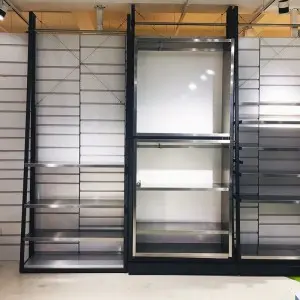Sep . 28, 2024 15:02 Back to list
Creating Engaging Display Fixtures for Enhanced Retail Experiences
Understanding Display Fixtures Enhancing Retail Environments
In the competitive landscape of retail, the importance of display fixtures cannot be overstated. These essential components serve not just to organize products, but to create engaging shopping experiences that can significantly influence consumer behavior. As retailers continue to innovate and adapt to changing market demands, understanding the integral role of display fixtures becomes critical.
Display fixtures encompass a wide variety of structures used to showcase products in retail settings. From shelves and racks to mannequins and hangers, these fixtures are designed to optimize space and enhance the presentation of merchandise. The choice of display fixtures can determine the flow of traffic within a store, affect customer engagement, and ultimately impact sales.
One of the primary functions of display fixtures is to showcase products in a visually appealing manner. Effective displays are strategically designed to catch the eye of potential buyers. For example, the arrangement of products should create a sense of harmony and balance, allowing items to stand out while still being part of an overall aesthetic. Retailers often employ principles of design—such as symmetry, color coordination, and texture contrast—to craft displays that draw shoppers in and encourage browsing.
Moreover, effective display fixtures enhance product accessibility. In an era where convenience is paramount, customers appreciate easy-to-navigate spaces. Well-placed shelves and racks allow for a seamless shopping experience, enabling customers to quickly locate desired items. Retailers must consider the height, spacing, and organization of fixtures to ensure that products are not only visible but also reachable by all customers, including those with disabilities.
display fixtures

In addition to visual appeal and accessibility, display fixtures play a vital role in storytelling and theme creation within retail spaces. A well-thought-out display can evoke emotions, convey brand values, and communicate seasonal themes. For instance, holiday-themed fixtures can create a sense of urgency and excitement, prompting customers to make impulse purchases. By aligning display strategies with marketing campaigns, retailers can strengthen brand identity and foster customer loyalty.
The right choice of materials for display fixtures also matters significantly. The durability of materials ensures that fixtures can withstand the wear and tear of everyday use, while also reflecting the brand’s ethos. Eco-friendly materials are increasingly popular as consumers become more environmentally conscious; thus, retailers who adopt sustainable practices can resonate with their target audience.
Furthermore, technology is revolutionizing the way retailers approach display fixtures. Digital displays, for instance, integrate multimedia elements that capture attention and convey information efficiently. Interactive displays encourage customer participation and engagement, transforming the shopping experience into a dynamic activity. As technology continues to evolve, the incorporation of smart fixtures that monitor customer interactions and preferences will become more prevalent, providing retailers with invaluable data to refine their strategies.
Finally, the evolution of e-commerce has necessitated a rethinking of traditional display fixtures. While physical stores strive to replicate the convenience of online shopping, innovative fixtures that blend digital and physical retail experiences are becoming essential. Click-and-collect setups, mobile charging stations, and augmented reality features can bridge the gap between in-store and online experiences, offering customers seamless integration.
In conclusion, display fixtures are more than mere product holders; they are powerful tools that, when utilized effectively, enhance the customer journey, reinforce brand identity, and drive sales. As retailers navigate the ever-changing market landscape, prioritizing the innovative use of display fixtures will be crucial in creating memorable shopping experiences that resonate with consumers. Successfully leveraging these elements can turn a simple retail space into a destination that attracts and retains customers in today’s fast-paced market.
-
The Benefits of Electronic Shelf Labels for Modern Stores
NewsJul.01,2025
-
Space-Saving Retail Store Furniture Designs for Small Shops
NewsJul.01,2025
-
Slatwall vs. Gridwall: Which Store Fixture is Right for Your Business?
NewsJul.01,2025
-
Shop Fittings: Essential Elements for a Functional Retail Space
NewsJul.01,2025
-
How to Design a Minimalist Cosmetic Shop Display
NewsJul.01,2025
-
Creative Clothes Shop Display Ideas to Attract More Customers
NewsJul.01,2025


















































































































